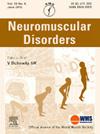Genotype and corticosteroid treatment are distinctively associated with gray matter characteristics in patients with Duchenne muscular dystrophy
IF 2.7
4区 医学
Q2 CLINICAL NEUROLOGY
引用次数: 0
Abstract
This study investigated if structural variation in specific gray matter areas is associated with corticosteroid treatment or genotype, and if cerebral morphological variations are related to neuropsychological and behavioral outcomes. The CAT12 toolbox in SPM was used for MRI segmentations, assessing subcortical structures, cortical thickness, gyrification, and sulci depths for DMD patients (n = 40; 9–18 years) and age-matched controls (n = 40). Comparisons were made between DMD vs. controls, daily vs. intermittent corticosteroid treatment (n = 20 each), and Dp140+ vs. Dp140- gene mutations (n = 15 vs. 25). MANCOVA, CAT12 3D statistics and Pearson correlations were conducted. DMD patients showed differences in volumes of distinct subcortical structures, left hemisphere cortical thickness, and gyrification in multiple brain areas compared with healthy controls. The daily treated DMD group exhibited differences in subcortical volumes and different patterns of cortical thickness, sulci depth, and gyrification compared to the intermittent treated DMD group. DMD Dp140+ patients displayed altered gyrification and sulci depth compared to DMD Dp140- patients. Finally, we found correlations between neurobehavioral outcomes and brain areas that showed differences in cortical morphology associated with corticosteroid treatment. Both genotype and corticosteroid treatment are associated with variations in subcortical volumes and cortical morphology, albeit in different ways. Corticosteroid treatment appears to have a more profound association with differences in gray matter characteristics of brain regions that are associated with functional outcomes.
基因型和皮质类固醇治疗与杜氏肌营养不良症患者的灰质特征明显相关。
本研究探讨了特定灰质区域的结构变异是否与皮质类固醇治疗或基因型有关,以及大脑形态变异是否与神经心理和行为结果有关。SPM 中的 CAT12 工具箱用于 MRI 分割,评估 DMD 患者(n = 40;9-18 岁)和年龄匹配的对照组(n = 40)的皮层下结构、皮层厚度、回变和沟深。对 DMD 与对照组、每日皮质类固醇治疗与间歇性皮质类固醇治疗(各 20 例)、Dp140+ 基因突变与 Dp140- 基因突变(15 例与 25 例)进行了比较。进行了 MANCOVA、CAT12 3D 统计和皮尔逊相关性分析。与健康对照组相比,DMD 患者在不同皮层下结构的体积、左半球皮层厚度和多个脑区的回旋方面存在差异。与间歇性治疗的 DMD 组相比,每日治疗的 DMD 组在皮层下体积以及皮层厚度、沟深度和回化模式方面存在差异。与 DMD Dp140- 患者相比,DMD Dp140+ 患者的回化和沟深度有所改变。最后,我们发现神经行为结果与大脑区域之间存在相关性,这些区域的皮质形态差异与皮质类固醇治疗有关。基因型和皮质类固醇治疗都与皮质下体积和皮质形态的变化有关,尽管方式不同。皮质类固醇治疗似乎与脑区灰质特征的差异有更密切的关系,而这些差异与功能结果有关。
本文章由计算机程序翻译,如有差异,请以英文原文为准。
求助全文
约1分钟内获得全文
求助全文
来源期刊

Neuromuscular Disorders
医学-临床神经学
CiteScore
4.60
自引率
3.60%
发文量
543
审稿时长
53 days
期刊介绍:
This international, multidisciplinary journal covers all aspects of neuromuscular disorders in childhood and adult life (including the muscular dystrophies, spinal muscular atrophies, hereditary neuropathies, congenital myopathies, myasthenias, myotonic syndromes, metabolic myopathies and inflammatory myopathies).
The Editors welcome original articles from all areas of the field:
• Clinical aspects, such as new clinical entities, case studies of interest, treatment, management and rehabilitation (including biomechanics, orthotic design and surgery).
• Basic scientific studies of relevance to the clinical syndromes, including advances in the fields of molecular biology and genetics.
• Studies of animal models relevant to the human diseases.
The journal is aimed at a wide range of clinicians, pathologists, associated paramedical professionals and clinical and basic scientists with an interest in the study of neuromuscular disorders.
 求助内容:
求助内容: 应助结果提醒方式:
应助结果提醒方式:


